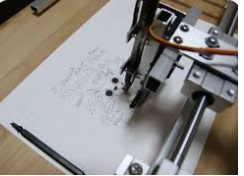A plotter is a specialized printer designed to produce high-quality graphics and drawings, especially for applications like engineering, architecture, and design. Unlike standard printers that create images through dots, plotters use pens or specialized printing technology to create continuous lines, allowing for precise and detailed outputs.
Pen Plotters:- Description: Use pens to draw images on paper. The pens move along the X and Y axes, allowing for precise line work.
- Example: HP DesignJet series.
- Diagram:
Inkjet Plotters:- Description: Utilize inkjet technology to spray ink onto the media. They can produce high-resolution images and are commonly used for large-format prints.
- Example: Canon image PROGRAF series.
- Diagram:
Laser Plotters:- Description: Use laser technology to fuse toner onto paper. They are faster than pen and inkjet plotters and are ideal for high-volume printing.
- Example: Xerox Color 700i.
- Diagram:
Flatbed Plotters:- Description: Have a flat surface where materials are placed. The print head moves over the material, making them suitable for thick or rigid substrates.
- Example: Roland Versa UV series.
- Diagram:
Roll-fed Plotters:- Description: Use rolls of media, allowing for continuous printing. These are often used for banners and large signs.
- Example: Epson Sure Color series.
Common Plotter Faults
Poor Print Quality
- Symptoms: Blurry lines, streaks, or faded prints.
- Causes: Low ink levels, clogged print heads, or incorrect settings.
- Troubleshooting:
- Check ink levels and replace cartridges if low.
- Run a print head cleaning cycle.
- Verify that print settings (resolution, paper type) are correct.
Paper Jams
- Symptoms: Printer stops and shows a paper jam error.
- Causes: Misaligned paper, using the wrong paper type, or debris in the paper path.
- Troubleshooting:
- Open the plotter and remove any jammed paper carefully.
- Ensure the paper is loaded correctly and not curled or wrinkled.
- Check for foreign objects in the paper path.
Connection Issues
- Symptoms: Plotter not responding or showing offline status.
- Causes: Loose cables, incorrect network settings, or driver issues.
- Troubleshooting:
- Check all cable connections and ensure they are secure.
- Restart the plotter and the computer.
- Reinstall or update the printer driver.
Inaccurate Scaling or Alignment
- Symptoms: Prints are not to scale or misaligned.
- Causes: Incorrect settings or calibration issues.
- Troubleshooting:
- Verify the scaling settings in the print dialog.
- Perform a calibration check according to the manufacturer’s instructions.
Unusual Noises
- Symptoms: Grinding or clicking noises during operation.
- Causes: Mechanical issues or foreign objects interfering with the mechanism.
- Troubleshooting:
- Inspect the interior for any obstructions.
- Check for worn-out parts that may need replacement.
Slow Printing Speed
- Symptoms: Prints take longer than expected.
- Causes: High-resolution settings, complex designs, or large file sizes.
- Troubleshooting:
- Adjust print settings for speed versus quality.
- Simplify the design or break it into smaller sections if possible.
Firmware Errors
- Symptoms: Error codes displayed on the screen or unexpected behavior.
- Causes: Outdated firmware or software glitches.
- Troubleshooting:
- Check the manufacturer’s website for firmware updates and install them.
- Reset the plotter to factory settings if necessary.
Poor Print Quality
- Symptoms: Blurry lines, streaks, or faded prints.
- Causes: Low ink levels, clogged print heads, or incorrect settings.
- Troubleshooting:
- Check ink levels and replace cartridges if low.
- Run a print head cleaning cycle.
- Verify that print settings (resolution, paper type) are correct.
Paper Jams
- Symptoms: Printer stops and shows a paper jam error.
- Causes: Misaligned paper, using the wrong paper type, or debris in the paper path.
- Troubleshooting:
- Open the plotter and remove any jammed paper carefully.
- Ensure the paper is loaded correctly and not curled or wrinkled.
- Check for foreign objects in the paper path.
Connection Issues
- Symptoms: Plotter not responding or showing offline status.
- Causes: Loose cables, incorrect network settings, or driver issues.
- Troubleshooting:
- Check all cable connections and ensure they are secure.
- Restart the plotter and the computer.
- Reinstall or update the printer driver.
Inaccurate Scaling or Alignment
- Symptoms: Prints are not to scale or misaligned.
- Causes: Incorrect settings or calibration issues.
- Troubleshooting:
- Verify the scaling settings in the print dialog.
- Perform a calibration check according to the manufacturer’s instructions.
Unusual Noises
- Symptoms: Grinding or clicking noises during operation.
- Causes: Mechanical issues or foreign objects interfering with the mechanism.
- Troubleshooting:
- Inspect the interior for any obstructions.
- Check for worn-out parts that may need replacement.
Slow Printing Speed
- Symptoms: Prints take longer than expected.
- Causes: High-resolution settings, complex designs, or large file sizes.
- Troubleshooting:
- Adjust print settings for speed versus quality.
- Simplify the design or break it into smaller sections if possible.
Firmware Errors
- Symptoms: Error codes displayed on the screen or unexpected behavior.
- Causes: Outdated firmware or software glitches.
- Troubleshooting:
- Check the manufacturer’s website for firmware updates and install them.
- Reset the plotter to factory settings if necessary.





Post a Comment
If you have any doubts, please let me know